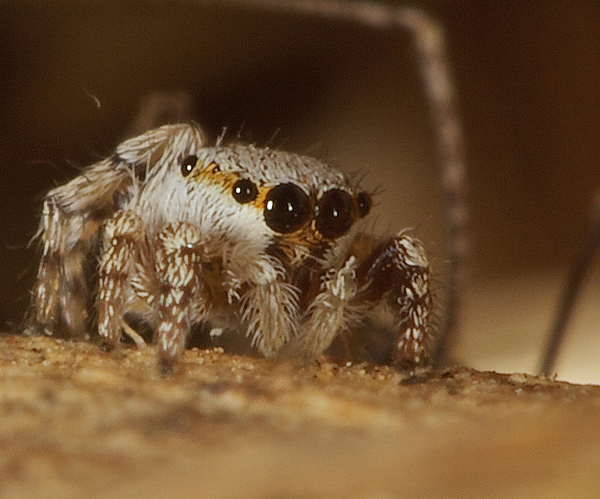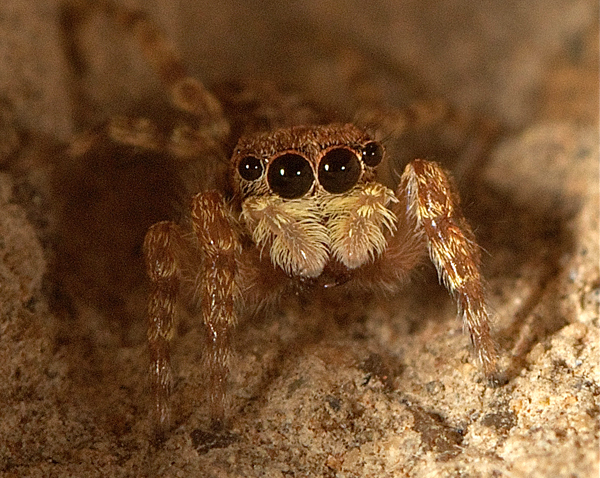Page 4 of 8
Re: Jumping Spider IDs and Comments
Posted: Wed Apr 29, 2020 6:14 pm
by ExFmem
Here are my remaining pics from Kruger:
Sept./Kruger
2017 file 2

Re: Jumping Spider IDs and Comments
Posted: Wed Apr 29, 2020 6:19 pm
by ExFmem
Sept./Kruger
2017 file 19 (sort of like file 8)

I think that’s about it. Next we can move to KTP, tho’ there are FAR fewer there from my experience.


Re: Jumping Spider IDs and Comments
Posted: Thu May 07, 2020 10:28 am
by Lisbeth
Those black spots are they all working eyes or do only the big ones work


Re: Jumping Spider IDs and Comments
Posted: Thu May 07, 2020 10:31 am
by Sprocky
Lisbeth wrote: ↑Thu May 07, 2020 10:28 am
Those black spots are they all working eyes or do only the big ones work


As far as I know, they are all working eyes.

Re: Jumping Spider IDs and Comments
Posted: Thu May 07, 2020 10:42 am
by Lisbeth
Very practical


Re: Jumping Spider IDs and Comments
Posted: Thu May 07, 2020 12:11 pm
by Klipspringer
Jumping spiders have a specialisation of eyes. The prey is spotted from long distance, often 40 cm or more, by secondary eyes (the small eyes) which have broader field of vision and serve as movement detectors, but do not make a sharp image of the object. When the moving object approaches to within 4–10 cm, the spider turns in its direction and catches it in the narrow angle of vision of the Anterior Median Eyes (the large frontal ones) whose large lenses permit telescopic sighting. The retina of the AME is “boomerang shaped”, and consists of about 1000 visual cells arranged into four differently specialised layers, most dense at the fovea. It is screened posteriorly by a dark pigment layer and can be moved by special muscles, which permit change of focus. The AME can form a high-resolution picture of the prey from a distance of 10 cm or closer; when the prey moves the muscles shift the retina to maintain its picture at the foveal area. During the “recognition” process the retina is in constant motion, the shape of the object is quickly scanned horizontally and at the same time the main eye is rotated along its main axis, a procedure apparently necessary for identification of moving objects. The spider begins pursuit of the prey from a distance of about 10 cm, stalking it from 4 cm and leaping at it from 2 to 1 cm when the prey image is most precise. It is supposed that Salticidae have colour vision. The acuity of vision of the AME is apparently even higher than in the compound eyes of insects and is comparable with the eyes of higher vertebrates.
Re: Jumping Spider IDs and Comments
Posted: Thu May 07, 2020 12:48 pm
by Lisbeth
Being so small it needs some specific help and it sure has got it


Klippie

Re: Jumping Spider IDs and Comments
Posted: Thu May 07, 2020 11:35 pm
by ExFmem
Re: KTP file 1 = none of the described genera
And when the experts realize it's a new Genus, I'll name it
Klipspringerii 
I'm still waiting to name a newly photographed cheetah or leopard after Mel

. Missed my chance when I was naming a new male cheetah and it didn't occur to me


a male can also be named Mel.

Re: Jumping Spider IDs and Comments
Posted: Fri May 08, 2020 6:11 am
by Klipspringer
ExFmem wrote: ↑Thu May 07, 2020 11:35 pm
Re: KTP file 1 = none of the described genera
And when the experts realize it's a new Genus, I'll name it
Klipspringerii 
I'm still waiting to name a newly photographed cheetah or leopard after Mel

. Missed my chance when I was naming a new male cheetah and it didn't occur to me


a male can also be named Mel.


But the issue is that the naming right is with the person who describes the new genus/species and never with the person who collected or spotted it first.
You can post the KTP Aeluridingsda and give it a common name though, we can be a bit creative here.
(In German we refer to everything we don't have a name/word for as a "Dingsda" or "Dingsbums", that would be one of my favs to name a new species).
Re: Jumping Spider IDs and Comments
Posted: Fri May 08, 2020 11:53 pm
by ExFmem
Klipspringer wrote: ↑Fri May 08, 2020 6:11 am
ExFmem wrote: ↑Thu May 07, 2020 11:35 pm
Re: KTP file 1 = none of the described genera
And when the experts realize it's a new Genus, I'll name it
Klipspringerii 

But the issue is that the naming right is with the person who describes the new genus/species and never with the person who collected or spotted it first.
You can post the KTP Aeluridingsda and give it a common name though, we can be a bit creative here.
(In German we refer to everything we don't have a name/word for as a "Dingsda" or "Dingsbums", that would be one of my favs to name a new species).


Yep, if we describe it first, the entry could be
Dingsda Jumping Spider Whatsitii dunno
Family: Pogostickidae
(Will write something up so we can get it to the AW book, with further updates as it's ID becomes clearer.)
Will also look into file 7 being same as file 8 (just diff. angle).

. Missed my chance when I was naming a new male cheetah and it didn't occur to me

a male can also be named Mel.

But the issue is that the naming right is with the person who describes the new genus/species and never with the person who collected or spotted it first.